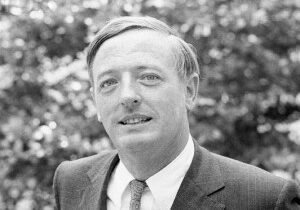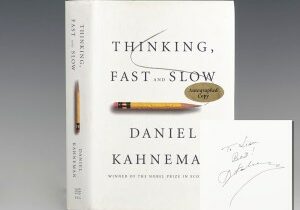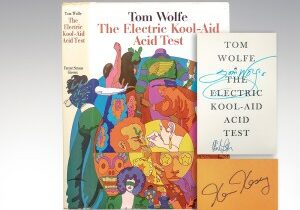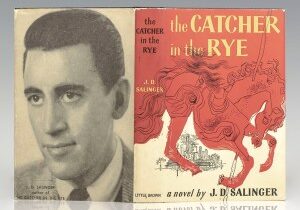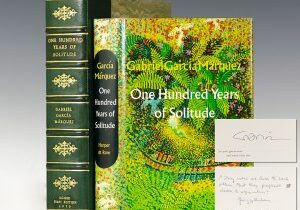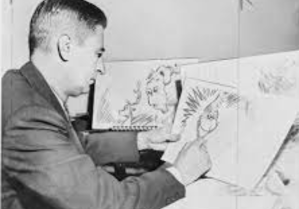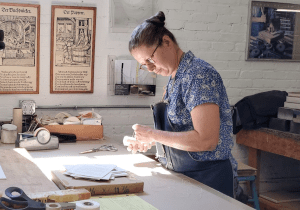American journalist and novelist Ernest Hemingway‘s legacy to American literature lies in his economical and understated writing style, which he termed the “iceberg theory” and writers who came after him either attempted to emulate or avoid. After his reputation was established with the publication of The Sun Also Rises, Hemingway essentially became the spokesperson for the post–World War I generation. His influence on 20th century fiction is unparalleled and his adventurous lifestyle and public image brought him admiration from later generations. Hemingway published seven novels throughout his career and was awarded the Pulitzer Prize for Fiction in 1953 and the Nobel Prize in literature in 1954.

First edition of Hemingway’s first published work Three Stories & Ten Poems; one of only 300 copies printed
Ernest Hemingway’s first collection, Three Stories and Ten Poems, was originally intended for William Bird’s Three Mountains Press. But following a meeting with Robert McAlmon (1896-1956) in Rapallo, Hemingway agreed for it to appear under the imprint of McAlmon’s Contact Publishing Co. As recorded on the colophon, the book was printed by Maurice Darantière of Dijon, who the year before had printed the first edition of Joyce’s Ulysses for Sylvia Beach. As a replacement, Hemingway offered Bird a selection of prose vignettes bearing the collective title in our time, and this collection is advertised on the lower wrapper of Three Stories & Ten Poems, but in the event it did not appear until the following year. In 1923 Maurice Darantiere, the printer of Joyce’s Ulysses and many other expatriate works, printed Hemingway’s first book Three Stories and Ten Poems in Dijon. Six of the poems had been previously published, the remaining four and all three stories (“Up in Michigan,” “Out of Season” and “My Old Man”) appear here for the first time.

Exceedingly rare first edition of Hemingway’s second short story collection In Our Time; one of 170 numbered copies printed on Rives hand-made paper
Hemingway’s second published collection, In Our Time, remains one of Hemingway’s rarest books, second only to Three Stories and Ten Poems both because of the limited number of copies printed and its fragile nature. Ezra Pound had arranged with William Bird, the owner of The Three Mountains Press to publish a series of six volumes by contemporary writers, under the collective title ‘The Inquest into the State of Contemporary English Prose’. Contributors included Pound himself, Ford Maddox Ford, William Carlos Williams and Ernest Hemingway. For his contribution Hemingway selected the 6 sketches that had already been published in The Little Review in 1924, to which he added a further 12. The resulting publication was titled in our time, an ironic reference to the twelfth line of the Episcopalian Evening Prayer: “Give peace in our time, O Lord”. In Our Time is a series of short vignettes, the work is a powerful statement on war and includes chapters written during Hemingway’s recent visits to Spain and the fictional account of the death of Maera, a renowned matador. Ezra Pound edited in our time, and it was later expanded into the American edition of 1925 in which these 18 chapters appeared interspersed among other classic Hemingway short stories.

First edition of Hemingway’s first novel, The Torrents of Spring; inscribed by him to his nephews. Association copies of Hemingway’s first novel seldom appear in the marketplace.
Hemingway’s first novella, The Torrents of Spring, was published in 1926. This third publication functioned both as a subversive critique of some contemporary writers whom Hemingway held in disdain, and as a ploy to enable a change of publishers. “Hemingway was planning a carefully engineered campaign for breaking his contract with Boni and Liveright and maneuvering to place his novel [The Sun Also Rises] with Scribner’s. The vehicle was… [the] satirical novel, The Torrents of Spring, which was clearly calculated to cause problems with his publisher, since it was a deliberate parody of Sherwood Anderson [Boni and Liveright’s best-selling author]. Boni and Liveright had the option on his next three books, one of which had to be a novel. If, however, they turned down the book that Hemingway submitted next, he was free of his obligations to the publisher and could go elsewhere.” Hemingway wrote Ezra Pound that he “had written ‘a funny book’… It was a satire on America, he claimed, ‘Probably unprintable but funny as hell… Wrote it to destroy Sherwood [Anderson] and various others… It’s first really adult thing have done. Jesus Christ it is funny… It is a regular novel only it shows up all the fakes of Anderson, Gertrude [Stein], [Sinclair] Lewis, [Willa] Cather, Hergo [Joseph Hergesheimer] and all the rest of the pretentious faking bastards… I don’t see how Sherwood will ever be able to write again” (Mellow, Hemingway).

First edition, first issue of the first printing of The Sun Also Rises. An exceptional example, most rare and desirable inscribed, especially in the year of publication.
Hemingway’s debut full-length novel, The Sun Also Rises was published by Scribner’s in 1926, and a year later in the United Kingdom by Jonathan Cape under the title Fiesta. Though it initially received mixed reviews, it is now “recognized as Hemingway’s greatest work” (Meyers, 1985). The fictional plot depicts a love story between war-wounded and impotent Jake Barnes and the promiscuous divorcée Lady Brett Ashley, but the novel is a roman à clef; the characters are based on real people and the action is based on real events. Hemingway proposes that the “Lost Generation,” considered to have been decadent, dissolute and irretrievably damaged by World War I, was resilient and strong. Naturally, themes of love, death, renewal in nature, and the nature of masculinity are heavily investigated. For example, the characters engage in bull-fighting, which is presented as an idealized drama: The matador faces death and, in so doing, creates a moment of existential nothingness, broken when he vanquishes the possibility of death by killing the bull (Stoltzfus, 2005).
Hemingway’s first novel published with Scribner’s, the book also coincides with the decline of his first marriage. His soon to be second wife, Pauline Pfeiffer, urged him toward Scribner’s as his publisher, despite the reticence of his first wife, Hadley Richardson. Despite the turmoil in Hemingway’s personal life, The Sun Also Rises established Hemingway as a talented novelist, and remains one of his greatest works to this day.
Men Without Women, a new collection of short stories also emerged from this fraught period of Hemingway’s life. The 14 stories in this early collection “are as clear and crisp and perfectly shaped as icicles, as sharp as splinters of glass. It is impossible to read them without realizing that seldom if ever before has a writer been able to cut so deeply into life” (Time). Included are “The Killers,” “Ten Indians,” “Today is Friday” and “Hills Like White Elephants,” as well as four stories published for the first time.
Hemingway’s early classic, A Farewell to Arms, established him among the American masters. Written during his 30th year, it was lauded as the best American novel to emerge from World War I. A Farewell to Arms is the unforgettable story of an American ambulance driver on the Italian front and his passion for a beautiful English nurse. Set against the looming horrors of the battlefield—weary, demoralized men marching in the rain during the German attack on Caporetto; the profound struggle between loyalty and desertion—this gripping, semiautobiographical work captures the harsh realities of war and the pain of lovers caught in its inexorable sweep. Hemingway’s own experience as an ambulance driver, and his early love for a nurse, informed the structure of the novel. He famously said that he rewrote the ending to A Farewell to Arms thirty-nine times to get the words right. It is the basis for the 1932 film bearing the same name directed by Frank Borzage and starring Gary Cooper, Helen Hayes, and Adolphe Menjou.
Published in 1932, Hemingway’s masterwork on bullfighting, Death in the Afternoon was praised by John Dos Passos as “an absolute model for how that sort of thing ought to be done,” and a contemporary review in The New York Herald Tribune described it as “full of the vigor and forthrightness of the author’s personality, his humor, his strong opinions—and language… In short, it is the essence of Hemingway” (Mellow, 415).

First edition of Hemingway’s classic collection of short stories, Winner Take Nothing. Inscribed by the author on the front free endpaper, “To D. White best wishes always Ernest Hemingway.” One of the rarest Hemingway titles to find signed and inscribed.
Written when Hemingway was at the height of his creative powers, the stories in Winner Take Nothing glow with the mark of his unique talent. Hunters, wives, old men of wisdom, waiters, fighters, women loved, women lost: they are all here, living on the raw edge, making love, facing the inevitable reality of death. The characters, the dialogue, the settings, the remarkable insight could have come only from Hemingway’s imagination. As an introduction to his work, or as an overview of the themes he developed at greater length in his novels, it is a stunningly successful collection.
Hemingway’s second work of nonfiction, Green Hills of Africa, was an account of a month on safari he and his wife took in East Africa during December 1933. It was published in 1935, but initially appeared in Scribner’s Magazine the same year (Meyers, 1985). The first edition explains that Hemingway “attempted to write an absolutely true book to see whether the shape of a country and the pattern of a month’s action can, if truly presented, compete with a work of the imagination.” The author’s intentions were quickly confirmed when the first print-run sold a popular 10,500 copies, and it was aptly praised by The New York Times as “[a] fine book on death in the African afternoon…The writing is the thing; that way he has of getting down with beautiful precision the exact way things look, smell, taste, feel, sound.” Not unlike Hemingway’s virtuosic abilities, Green Hills of Africa also offers the writer’s opinions on the value of his contemporaries: “The good American writers are Henry James, Stephen Crane, and Mark Twain Henry James wanted to make money. He never did, of course.” Hemingway adds that most American writers are inadequate and “came to a bad end” The value of Green Hills of Africa, therefore, is three-fold. It serves as masterly written entertainment, a successful social experiment that tested the receptivity of the American public, and an insight into the author’s literary evaluation.

First edition of Hemingway’s classic novel about smuggling, intrigue, and love, To Have and Have Not.
Hemingway’s first novel since A Farewell to Arms, To Have and Have Not follows the life and adventures of Harry Morgan from rum-running to revolution. Brimming with criticism directed at American capitalism and the bureaucracy of the Roosevelt administration, the novel explores social circumstances and situations in Key West, “that paradise of the ‘haves’ and purgatory of the ‘have nots.” “In To Have and Have Not, Hemingway for the first time showed an interest in a possible solution of social problems through collective action” (Hart, 327).
The Fifth Column and the First Forty-Nine Stories contains Hemingway’s only full-length play, The Fifth Column, and 49 short stories. Many of the stories included in the collection appear in other collections, including “In Our Time,” “Men Without Women,” “Winner Take Nothing” and “The Snows of Kilimanjaro.” Some of the collection’s important stories are rather short, though “The Snows of Kilimanjaro” and “The Short Happy Life of Francis Macomber” are longer stories.
The novel that is regarded as one of Hemingway’s best works, For Whom The Bell Tolls brings together two of the author’s recurring obsessions: war and personal honor. “This is the best book Ernest Hemingway has written, the fullest, the deepest, the truest. It will, I think, be one of the major novels of American literature Hemingway has struck universal chords, and he has struck them vibrantly” (J. Donald Adams).
Published in 1950 and set in Venice at the close of World War II, Across the River and Into the Trees tells the bittersweet story of a middle-aged American colonel, scarred by war and in failing health, who finds love with a young Italian countess at the very moment when his life is becoming a physical hardship to him. It is a love so overpowering and spontaneous that it revitalizes the man’s spirit and encourages him to dream of a future, even though he knows that there can be no hope for long. Spanning a matter of hours, Across the River and into the Trees is tender and moving, yet tragic in the inexorable shadow of what must come.

First edition of Hemingway’s Pulitzer Prize-winning novel and arguably his most famous work, The Old Man and the Sea.
In 1940, Hemingway and his third wife Martha Gellhorn purchased Finca Vigía, a 15-acre property 15 miles from Havana where Hemingway would write much of For Whom the Bell Tolls, and later, The Old Man and the Sea. Hemingway became a fixture of Havana and was known to frequent many of the local hotel bars including that of the Hotel Nacional de Cuba which hosted a number of important guests, including artists, actors, athletes, writers and statesmen such as Winston Churchill, the Duke and Duchess of Windsor, Jimmy Carter, Frank Sinatra, Ava Gardner, Rita Hayworth, Mickey Mantle, Johnny Weissmuller, Buster Keaton, Jorge Negrete, Agustín Lara, Rocky Marciano, Tyrone Power, Rómulo Gallegos, Errol Flynn, John Wayne, Marlene Dietrich, Gary Cooper, and Marlon Brando. Upon its publication in 1952 by Charles Scribner’s Sons, The Old Man and the Sea was awarded the Pulitzer Prize for Fiction the following year and was cited by the Nobel Committee as contributing to the awarding of the Nobel Prize in Literature to Hemingway in 1954. The novel reinvigorated Hemingway’s literary reputation. It initiated a reexamination of his entire body of work. The novel was received with such alacrity, that it restored many readers’ confidence in Hemingway’s capability as an author. Indeed, the publisher even wrote on an early dust jacket, calling the novel a “new classic,” and it was compared by many critics to such revered works as William Faulkner’s “The Bear” and Herman Melville’s Moby-Dick.

Rare letter excerpt boldly signed by Ernest Hemingway
Hemingway remains one of the most recognizable and influential novelists of the 20th century. The extent of his influence is seen from the enduring and varied tributes to Hemingway and his works. Three houses associated with Hemingway are listed on the U.S. National Register of Historic Places: the Ernest Hemingway Cottage on Walloon Lake, Michigan, designated in 1968; the Ernest Hemingway House in Key West, designated in 1968; and the Ernest and Mary Hemingway House in Ketchum, designated in 2015. Hemingway’s childhood home in Oak Park and his Havana residence were also converted into museums.Browse the complete current collection of the works of Ernest Hemingway here.









